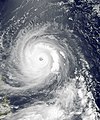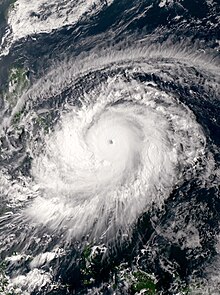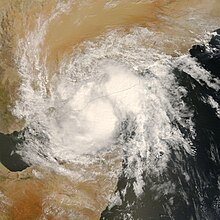Portal:Tropical cyclones
The Tropical Cyclones Portal

A tropical cyclone is a storm system characterized by a large low-pressure center, a closed low-level circulation and a spiral arrangement of numerous thunderstorms that produce strong winds and heavy rainfall. Tropical cyclones feed on the heat released when moist air rises, resulting in condensation of water vapor contained in the moist air. They are fueled by a different heat mechanism than other cyclonic windstorms such as Nor'easters, European windstorms and polar lows, leading to their classification as "warm core" storm systems. Most tropical cyclones originate in the doldrums, approximately ten degrees from the Equator.
The term "tropical" refers to both the geographic origin of these systems, which form almost exclusively in tropical regions of the globe, as well as to their formation in maritime tropical air masses. The term "cyclone" refers to such storms' cyclonic nature, with anticlockwise rotation in the Northern Hemisphere and clockwise rotation in the Southern Hemisphere. Depending on its location and intensity, a tropical cyclone may be referred to by names such as "hurricane", "typhoon", "tropical storm", "cyclonic storm", "tropical depression" or simply "cyclone".
Types of cyclone: 1. A "Typhoon" is a tropical cyclone located in the North-west Pacific Ocean which has the most cyclonic activity and storms occur year-round. 2. A "Hurricane" is also a tropical cyclone located at the North Atlantic Ocean or North-east Pacific Ocean which have an average storm activity and storms typically form between May 15 and November 30. 3. A "Cyclone" is a tropical cyclone that occurs in the South Pacific and Indian Oceans.
Selected named cyclone -
Typhoon Surigae, known in the Philippines as Super Typhoon Bising, was the strongest Northern Hemisphere tropical cyclone to form before the month of May, one of the most intense tropical cyclones on record and the strongest tropical cyclone worldwide in 2021. The second named storm, first typhoon and first super typhoon of the 2021 Pacific typhoon season, Surigae originated from a low-pressure area south of the Micronesian island of Woleai that organized into a tropical depression on April 12. At 18:00 UTC that day, it strengthened to a tropical storm and was named Surigae by the Japan Meteorological Agency (JMA). The formation of an eye and increasing winds prompted the JMA to upgrade the system to a severe tropical storm on April 13. The storm continued to gradually strengthen, and late on April 15, Surigae became a typhoon. Very favorable environmental conditions then allowed Surigae to begin a bout of rapid intensification; Surigae became a super typhoon the next day, and by April 17, the storm reached its peak intensity, with 10-minute sustained winds of 220 km/h (140 mph), 1-minute sustained winds of 315 km/h (196 mph), and a minimum pressure of 895 hPa (26.4 inHg). This made it the strongest pre-May typhoon on record. Afterward, the storm's weakening outflow and an eyewall replacement cycle caused Surigae to gradually weaken as its track shifted north-northwestward in the Philippine Sea. Following the eyewall replacement cycle, Surigae became an annular tropical cyclone on April 19, and restrengthened slightly. On April 22, the storm began to rapidly weaken as it accelerated northwestward into unfavorable environmental conditions, transitioning into a subtropical storm the next day. The subtropical system subsequently underwent extratropical transition, which it completed by April 24. Afterward, Surigae's extratropical remnant accelerated northeastward. On April 27, Surigae's remnant explosively intensified into a bomb cyclone near the Aleutian Islands, attaining hurricane-force winds. Afterward, the system gradually weakened as it turned eastward, slowing down in the process, before crossing the International Date Line on April 30 and fully dissipating on May 2.
Upon Surigae's naming, watches and warnings were issued for the island of Yap in the Federated States of Micronesia and the islands of Koror and Kayangel in Palau as well. The typhoon left US$4.8 million in damage in Palau after cutting off power, water, and destroying infrastructure. Later, warnings were raised for parts of the Philippines as the typhoon moved closer to the nation, with evacuations taking place in eastern regions of the Visayas. The storm killed at least 10 people and left another eight missing, in addition to causing at least ₱272.8 million (US$5.67 million) in damage in the Philippines. (Full article...)Selected article -
Deep Depression ARB 02 was a weak yet costly tropical cyclone which caused extensive damage and loss of life in Yemen. The sixth tropical cyclone and third deep depression of the 2008 North Indian Ocean cyclone season, ARB 02 formed in the Arabian Sea on October 19 from the same broader system which would spawn Moderate Tropical Storm Asma in the southern Indian Ocean around that time. Moving generally westward, the depression failed to intensify further, reaching maximum sustained winds of 55 km/h (35 mph). It would weaken, becoming a remnant low on October 23. Later that day, the system's remnants would made landfall near Ash Shihr in eastern Yemen.
The storm sent a plume of moisture throughout the Arabian Peninsula, contributing to dust storms as far north as Iraq. However, the effects were most severe in Yemen, becoming the second-worst natural disaster in the country after deadly floods in 1996. The storm dropped heavy rainfall in a normally arid region, reaching around 91 mm (3.6 in), which caused flash flooding in valleys after waterways were unable to contain the approximately 2 billion km3 (528 billion gallons) of water that fell. Poor drainage practices and an invasive species of weed contributed to the floods, which damaged or destroyed 6,505 houses, leaving about 25,000 people homeless. The floods killed 180 people and severely disrupted the livelihoods of about 700,000 residents of Hadhramaut and Al Mahrah governorates, mostly farmers whose fields were washed away. Some of the buildings at the Shibam UNESCO World Heritage Site collapsed due to the floods. Overall damage was estimated at US$874.8 million, although residual losses from damaged infrastructure were estimated to cost an additional US$726.9 million. The overall economic impact of the storm was therefore estimated at US$1.638 billion, equating to roughly 6% of the country's gross domestic product. (Full article...)Selected image -

Selected season -

The 1998 Atlantic hurricane season was a catastrophic and deadly Atlantic hurricane season, featuring the highest number of storm-related fatalities in over 218 years and some of the costliest ever at the time. The season had above average activity, due to the dissipation of an El Niño event and transition to La Niña conditions. It officially began on June 1 and ended on November 30, dates which conventionally delimit the period during which most tropical cyclones form in the Atlantic Ocean. The season had a rather slow start, with no tropical cyclones forming in June. The first tropical cyclone, Tropical Storm Alex, developed on July 27, and the season's final storm, Hurricane Nicole, became extratropical on December 1.
Several storms made landfall or directly affected land. Hurricane Bonnie made landfall in southeastern North Carolina as a Category 2 hurricane in late August, killing five people and causing about $1 billion in damage. Hurricane Earl caused $79 million in damage and three deaths after making landfall in Florida as a Category 1 hurricane. (Full article...)Related portals
Currently active tropical cyclones

Italicized basins are unofficial.
- North Atlantic (2024)
- No active systems
- East and Central Pacific (2024)
- No active systems
- West Pacific (2024)
- No active systems
- North Indian Ocean (2024)
- No active systems
- Mediterranean (2023–24)
- No active systems
- South-West Indian Ocean (2023–24)
- No active systems
- Australian region (2023–24)
- No active systems
- South Pacific (2023–24)
- No active systems
- South Atlantic (2023–24)
- No active systems
Last updated: 21:54, 8 May 2024 (UTC)
Tropical cyclone anniversaries

May 10
- 1972 - Cyclone Hannah impacts Papua New Guinea as a weak cyclone.
- 2002 - The 2002 Oman cyclone made landfall in Oman, bringing up to 250 mm (9.8 in) of rain.
- 2015 - Typhoon Noul (pictured) made landfall over in Santa Ana, Cagayan at Category 5 typhoon intensity.

May 11
- 1965 - The first of two cyclones to impact Bangladesh in 1965 made landfall on the country. These two storms collectively killed 47,000 people.
- 2019 - Cyclone Lili (pictured) made landfall over East Timor before dissipating the same day. The storm caused significant flooding over the island.

- May 12, 1991 - Typhoon Walt (pictured) reached its peak intensity to the east of the Philippines with 260 km/h (160 mph) winds. Cyclone Lisa developed in the Southern Hemisphere concurrently with Walt.
Did you know…




- …that the Joint Typhoon Warning Center considers that Typhoon Vera (pictured) of 1986 is actually two distinct systems, formed from two separated low-level circulations?
- …that Hurricane Agatha (pictured) was the strongest Pacific hurricane to make landfall in Mexico in May since records began in 1949?
- …that Cyclone Raquel (track pictured) travelled between the Australian and South Pacific basins between the 2014–15 and 2015–16 seasons, spanning both seasons in both basins?
- …that Cyclone Amphan (pictured) in 2020 was the first storm to be classified as a Super Cyclonic Storm in the Bay of Bengal since 1999?
General images -

Since 1950, 144 known hurricanes, tropical storms and tropical depressions have affected the U.S. state of Maryland. Many of these storms also affect the country's capital, Washington, D.C., since the city is located on territory ceded by Maryland. Hurricanes are the most intense classification of these storms, while tropical storms and tropical depressions are generally weaker. The Delmarva Peninsula is often affected by cyclones that brush the East Coast. Central and Western Maryland, as well as Washington, D.C., commonly receive rainfall from the remnants of storms that make landfall elsewhere and track northward. On rare occasions, the area experiences the effects of Pacific storms; one such example of this is Hurricane Tico, which made landfall on Mexico and moved inland.
Hurricane Agnes of the 1972 season was the deadliest storm, killing 19 people as a result of heavy flooding. The most damaging storm was Hurricane Irene, which resulted in $151 million in damage. Hurricane Hazel caused sustained hurricane-force winds (winds of 75 mph (120 km/h) or greater) in the state, the only storm during the time period to do so. No storms made landfall in Maryland at hurricane intensity. Since 1950, thirteen tropical cyclones have collectively killed 64 people. (Full article...)Topics
Subcategories
Related WikiProjects
WikiProject Tropical cyclones is the central point of coordination for Wikipedia's coverage of tropical cyclones. Feel free to help!
WikiProject Weather is the main center point of coordination for Wikipedia's coverage of meteorology in general, and the parent project of WikiProject Tropical cyclones. Three other branches of WikiProject Weather in particular share significant overlaps with WikiProject Tropical cyclones:
- The Non-tropical storms task force coordinates most of Wikipedia's coverage on extratropical cyclones, which tropical cyclones often transition into near the end of their lifespan.
- The Floods task force takes on the scope of flooding events all over the world, with rainfall from tropical cyclones a significant factor in many of them.
- WikiProject Severe weather documents the effects of extreme weather such as tornadoes, which landfalling tropical cyclones can produce.
Things you can do
 |
Here are some tasks awaiting attention:
|
Wikimedia
The following Wikimedia Foundation sister projects provide more on this subject:
-
Commons
Free media repository -
Wikibooks
Free textbooks and manuals -
Wikidata
Free knowledge base -
Wikinews
Free-content news -
Wikiquote
Collection of quotations -
Wikisource
Free-content library -
Wikiversity
Free learning tools -
Wikivoyage
Free travel guide -
Wiktionary
Dictionary and thesaurus
























































